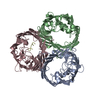+Search query
-Structure paper
| Title | Mating pair stabilization mediates bacterial conjugation species specificity. |
|---|---|
| Journal, issue, pages | Nat Microbiol, Vol. 7, Issue 7, Page 1016-1027, Year 2022 |
| Publish date | Jun 13, 2022 |
 Authors Authors | Wen Wen Low / Joshua L C Wong / Leticia C Beltran / Chloe Seddon / Sophia David / Hok-Sau Kwong / Tatiana Bizeau / Fengbin Wang / Alejandro Peña / Tiago R D Costa / Bach Pham / Min Chen / Edward H Egelman / Konstantinos Beis / Gad Frankel /   |
| PubMed Abstract | Bacterial conjugation mediates contact-dependent transfer of DNA from donor to recipient bacteria, thus facilitating the spread of virulence and resistance plasmids. Here we describe how variants of ...Bacterial conjugation mediates contact-dependent transfer of DNA from donor to recipient bacteria, thus facilitating the spread of virulence and resistance plasmids. Here we describe how variants of the plasmid-encoded donor outer membrane (OM) protein TraN cooperate with distinct OM receptors in recipients to mediate mating pair stabilization and efficient DNA transfer. We show that TraN from the plasmid pKpQIL (Klebsiella pneumoniae) interacts with OmpK36, plasmids from R100-1 (Shigella flexneri) and pSLT (Salmonella Typhimurium) interact with OmpW, and the prototypical F plasmid (Escherichia coli) interacts with OmpA. Cryo-EM analysis revealed that TraN interacts with OmpK36 through the insertion of a β-hairpin in the tip of TraN into a monomer of the OmpK36 porin trimer. Combining bioinformatic analysis with AlphaFold structural predictions, we identified a fourth TraN structural variant that mediates mating pair stabilization by binding OmpF. Accordingly, we devised a classification scheme for TraN homologues on the basis of structural similarity and their associated receptors: TraNα (OmpW), TraNβ (OmpK36), TraNγ (OmpA), TraNδ (OmpF). These TraN-OM receptor pairings have real-world implications as they reflect the distribution of resistance plasmids within clinical Enterobacteriaceae isolates, demonstrating the importance of mating pair stabilization in mediating conjugation species specificity. These findings will allow us to predict the distribution of emerging resistance plasmids in high-risk bacterial pathogens. |
 External links External links |  Nat Microbiol / Nat Microbiol /  PubMed:35697796 / PubMed:35697796 /  PubMed Central PubMed Central |
| Methods | EM (single particle) |
| Resolution | 2.7 Å |
| Structure data | EMDB-25567, PDB-7szi: |
| Source |
|
 Keywords Keywords |  MEMBRANE PROTEIN / Bacterial Conjugation / Mating pair stabilization / MEMBRANE PROTEIN / Bacterial Conjugation / Mating pair stabilization /  Single Particle Analysis / Outer Membrane Protein Complex Single Particle Analysis / Outer Membrane Protein Complex |
 Movie
Movie Controller
Controller Structure viewers
Structure viewers About Yorodumi Papers
About Yorodumi Papers






